
Agile is a software development methodology that focuses on flexibility, people, results, shorter delivery times, and adaptive planning.
It aims for continuous quality improvement and strives to deliver clean, individual software components instead of an entire application. The Agile approach is designed considering the rapidly changing nature of the technology landscape.
This article gives a comprehensive overview of the Agile software development approach, its values and principles, its types, and its benefits.
What is Agile Software Development?
Agile software development approach was conceived to manage large-scale software projects more efficiently. Agile development expedites the development process by delivering a larger product in multiple phases.
It is a flexible and iterative approach to software development that focuses on collaboration, customer feedback, and rapid delivery. Unlike the traditional waterfall model, where every phase is planned ahead and executed linearly.
Agile vs. Waterfall Model: Understanding the Difference
Agile and Waterfall methodologies are two popular approaches to software development. Waterfall is older while Agile software development approach is the latest of the two.
Agile is widely used in modern software development, but that doesn’t mean that the Waterfall model has become obsolete. Each approach has its benefits according to the project needs. Here are their key differences:
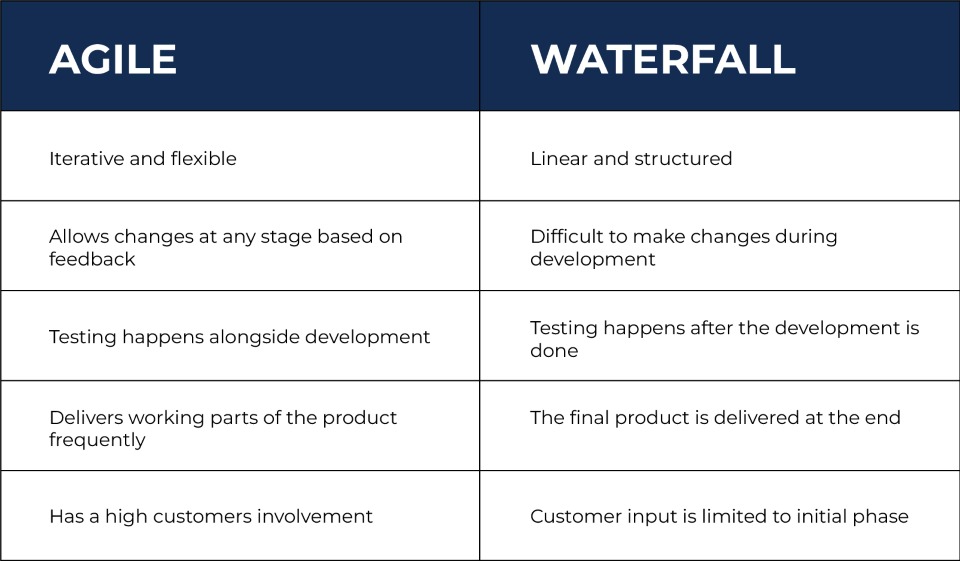
The 4 Agile Values
In 2001, several software developers huddled together to explore the idea of lightweight software development. They concluded their meeting by outlining four core values and twelve principles in what came to be known as the Agile Manifesto.
Here are the 4 values outlined in the manifesto.
-
Individuals and Interactions > Processes and Tools
This is an Agile value that reflects the greater importance the approach gives to people and their interactions rather than tools and processes.
According to the Agile Manifesto, people and their interactions should drive the software development process, for they respond to business demands, not processes or tools.
If you give tools more important than people, your team will become resistant to change.
-
Working Software > Documentation
Before the Agile software development approach, software houses spent significant time documenting the details of their software during the development phase.
This naturally led to delays in the development journey. Agile does not forsake product documentation; it only streamlines it such that developers have access only to the necessary data, thus reducing the development time.
The approach focuses on prioritizing the delivery of working software rather than extensive product documentation.
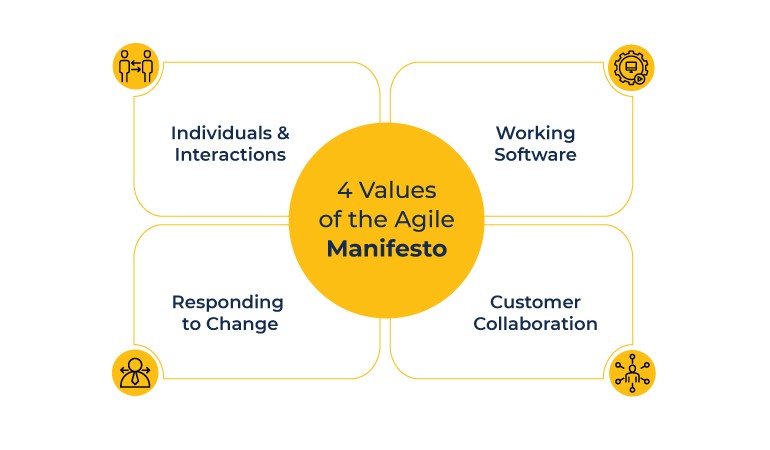
-
Customer Collaboration > Contract Negotiations
The third value of the Agile methodology is the importance it gives to collaboration between customers and project managers over contract negotiations between them.
Such collaboration involves the customer at every stage of the development process, not just at the start and end. This allows your development team to understand and deliver customer requirements more efficiently.
-
Responding to Change > Following a Plan
The fourth and last value of the Agile methodology lays emphasis on responding to change as opposed to following a fixed plan.
This value emanates from the weakness of the traditional software development approach that avoided change as it was deemed an added expense.
However, Agile uses short iterations in its product development lifecycle to allow developers to modify processes as per need. It values change and considers it a way of improving the end product.
* The ‘>’ sign reflects the importance of one facet over another.
The Twelve Principles of Agile
Apart from its four values, the Agile Manifesto also laid down twelve principles of the Agile software development approach.
They are as follows:
- Achieve customer satisfaction using early and continuous delivery of quality software.
- Welcome changing requirements, even if they come up at later stages of the development cycle.
- Deliver working software in a shorter amount of time.
- Software developers and business executives should collaborate daily throughout the entire project.
- Give your projects to motivated employees. Motivate your developers by giving them a conducive environment and trusting them to deliver the project.
- In-person conversations are the best way to communicate with the development team. It is also the best way for developers to communicate amongst themselves.
- The most critical measure of a development team’s success is working software.
- Sustainable development is a key goal of the Agile approach. Developers, users, and investors should be able to continue working at a given pace for an indefinite period.
- You can improve agility by paying constant attention to technical supremacy and good design.
- Self-organizing teams deliver the best designs, requirements, and architectures.
- Break down work into smaller chunks to become more efficient.
- The development team should introspect regularly, trying to find out how to become more effective and then change tact accordingly.
The Agile Software Development Cycle
The agile software development cycle has six stages. We have briefly explained each stage below.
- Concept – this is the first stage of Agile platform development and relates to identifying business opportunities in various projects. It also entails determining the time and work a project will require for completion. This stage is pivotal in helping managers decide which projects are worth pursuing based on financial viability and technical complexity.
- Inception – during the inception stage, you build a team by identifying its members, establishing funding sources, and discussing preliminary project requirements with the customer. This stage also involves establishing a timeframe for a sprint (a specified period for a specific amount of work) and outlining the responsibilities of various team members.
- Iteration/construction – this is the stage where the actual work on software development frameworks begins. The Agile software development cycle uses iterations to break down the development process into smaller tasks. Each iteration has a specific time (usually two to four weeks) and aims to produce working software at its completion. These iterations are also called single development cycles, and each iteration builds upon another to drive the development process to the next stage.
- Release – the fourth stage of Agile platform development is all about QA testing, identifying errors, and fixing them. It also involves completing system and user documentation and releasing the final iteration to production.
- Production – this stage relates to providing maintenance support to the software. This phase involves ensuring the smooth running of the software as well as user training by the development team. It lasts until the product retires or its support comes to an end.
- Retirement – this is the final stage in the Agile software development life cycle. It involves end-of-life tasks like informing customers and executing migrations. You also need to remove the system release from production during this stage.
The Different Types of Agile Methodologies
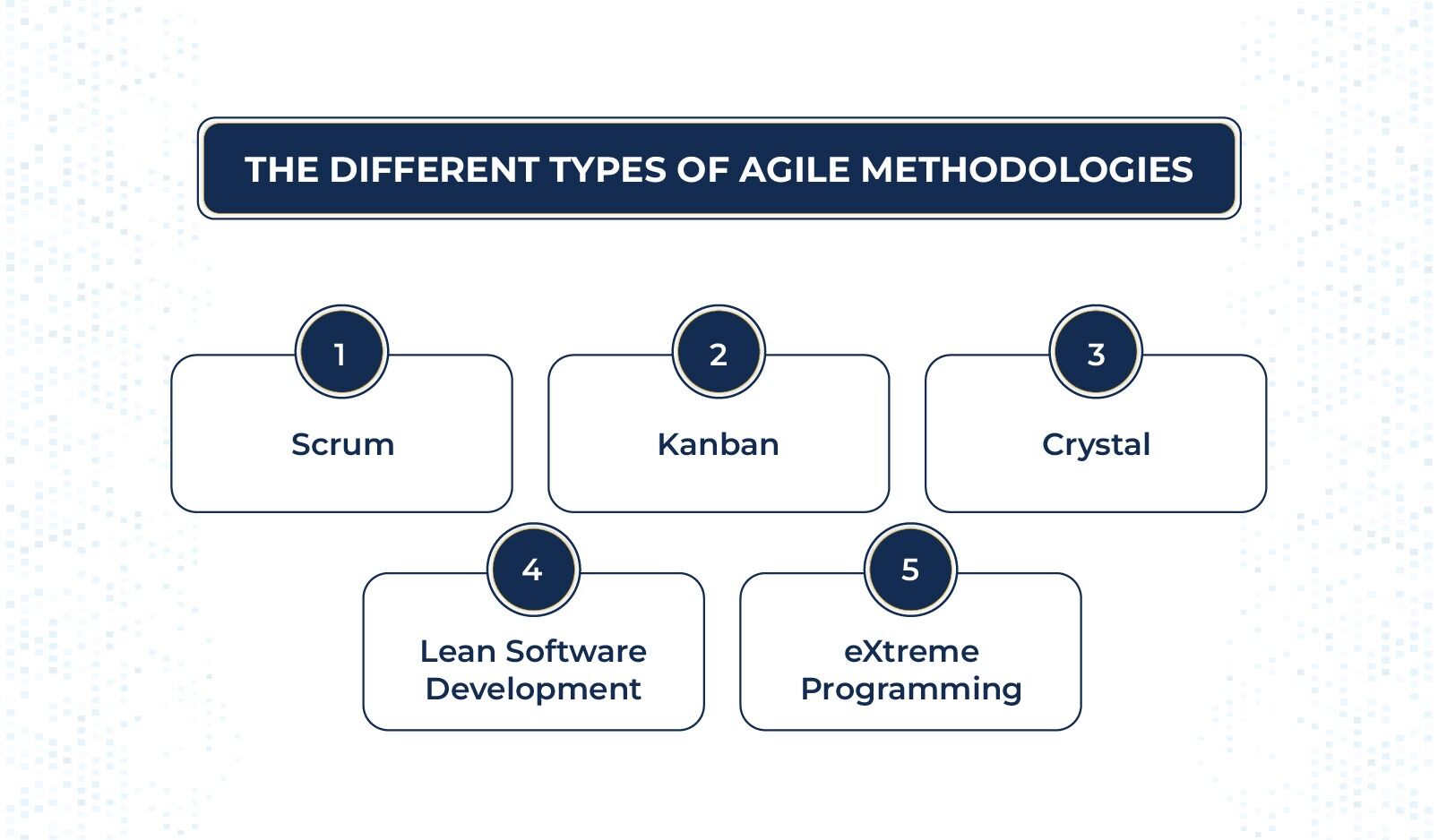 Every type of Agile methodology aims to deliver working software as efficiently as possible. To achieve this, all Agile approaches embrace and welcome change.
Every type of Agile methodology aims to deliver working software as efficiently as possible. To achieve this, all Agile approaches embrace and welcome change.
The difference between the various types of Agile methodologies stems from how they define the stages of the software development process.
This article will discuss five widely used types of Agile approaches.
-
Scrum
Scrum is a lightweight Agile software development approach that project managers use to handle incremental and iterative projects.
It’s not an acronym; instead, it takes its name from a rugby practice whereby players come together to figure out how to take the ball ahead. In software development, this translates into how to take the product or project ahead.
Many people consider Scrum and agile to be the same, but that’s not the case. While Scrum is a project management framework, Agile is a project management philosophy. Agile is all about continuous improvement and short, frequent product releases.
Scrum is a project management framework based on lean thinking and empiricism – it is a way of following the Agile software development model.
Moreover, Scrum has three principles it operates transparency, inspection, and adaptation. Following these principles makes Scrum an empirical software development approach.
Similarly, lean thinking implies that Scrum reduces waste while emphasizing the essentials. Continuous learning through experimentation lies at the heart of the Scrum project management framework.
A Scrum team has three specific roles: a product owner, a Scrum master, and developers.
Since Scrum teams are cross-functional in nature, they also possess designers, UX experts, testers, and ops engineers. The size of a Scrum is usually around ten people.
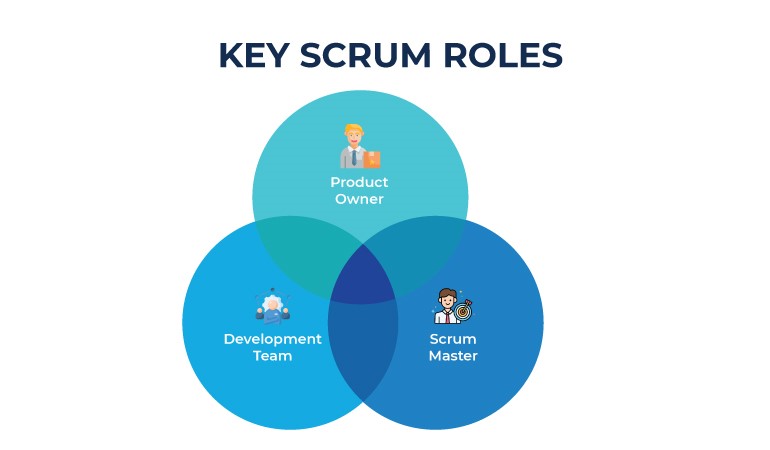 Brief Description of Roles in a Scrum Team
Brief Description of Roles in a Scrum Team
- Product owner – a product owner in Scrum is responsible for understanding customer and market requirements and prioritizing the engineering team’s work. Product owners build and manage the product backlog, give clear guidelines to members, and enable effective collaboration by ensuring every team member understands the deliverables in the product backlog.
There are never two product owners in a Scrum team, and product owners are not always product managers as well.
- Scrum master – a Scrum master is responsible for coaching not only the Scrum team but also the business on the principles, process, and theory of Scrum. They aim to streamline the Scrum processes insofar as possible. Therefore, it is necessary that a Scrum master possesses a deep understanding of the work their team is doing. A Scrum master is also responsible for arranging the human and logistical resources for their team for sprint planning, sprint review, sprint retrospective, etc.
- Developers – these resources are not necessarily software developers; they can work on any aspect of the project, whether software-related or not. Their role is to facilitate the development process by means of designing, creating, testing, or shipping the product. Moreover, a developer’s skill set in a Scrum team varies depending on the nature of their work. They are responsible for instilling quality, creating a sprint plan (sprint backlog), tweaking their plan daily to achieve the sprint goal, and holding other members accountable for their work or the lack thereof. Scrum developers also need soft skills like teaching, mentoring, coaching, etc.
-
Kanban
Kanban is a project management framework developed by the Japanese engineer Taichi Ohno, who worked for Toyota.
Ohno was an industrial engineer who devised Kanban for efficient and lean manufacturing. It emerged as an excellent tool to run a production system as a whole and encourage improvement.
Kanban uses task visualization to manage the workflow. As an Agile development approach, Kanban also focuses on continuous delivery while minimizing the stress of continuous delivery on the software development cycle.
It is based on the following three principles:
- Visualization of the workflow
- Minimizing the amount of work-in-progress
- Improving the flow of work or maximizing efficiency
Kanban fosters a culture of collaboration and continuous improvement. It helps team members and different departments work together effectively.
Moreover, since it aims to develop an optimal workflow, there is always an active ongoing learning and improvement aspect in the Kanban framework.
-
Lean Software Development
Lean software development is another Agile software development approach. It focuses on eliminating waste, optimizing resources and development time, and delivering only the product’s requirements.
Lean software development (LSD) is premised on the concept that there is room for improvement and elimination of waste at every level of a process.
These levels are individual, departmental, inter-departmental, organizational, and between the organization and its external stakeholders like customers and suppliers.
LSD is based on the following seven principles:

Lean software development uses reliable, quick feedback between customers and developers to create fast and efficient workflows.
It gives decision-making authority to individuals and teams to achieve this rather than relying on a hierarchical structure that limits the permission to make important decisions.
It also requires users to select and focus on the most important features of their system, then prioritize them and deliver them in small groups or batches. Moreover, LSD strives to ensure each team member is as productive as possible.
-
eXtreme Programming
eXtreme programming (XP) is another Agile software development approach focusing on continuous delivery and speed. It highlights customer satisfaction as one of its most essential principles.
With the XP approach, you can deliver software in short intervals (three to four weeks). It also encourages continuous planning and testing, fast feedback loops, close teamwork, and customer involvement.
The goal of XP, like any other Agile approach, is to enhance software quality and improve responsiveness to meet changing customer needs.
XP also has its own set of values it aspires to imbibe and reflect. These are simplicity, courage, respect, communication, and feedback.
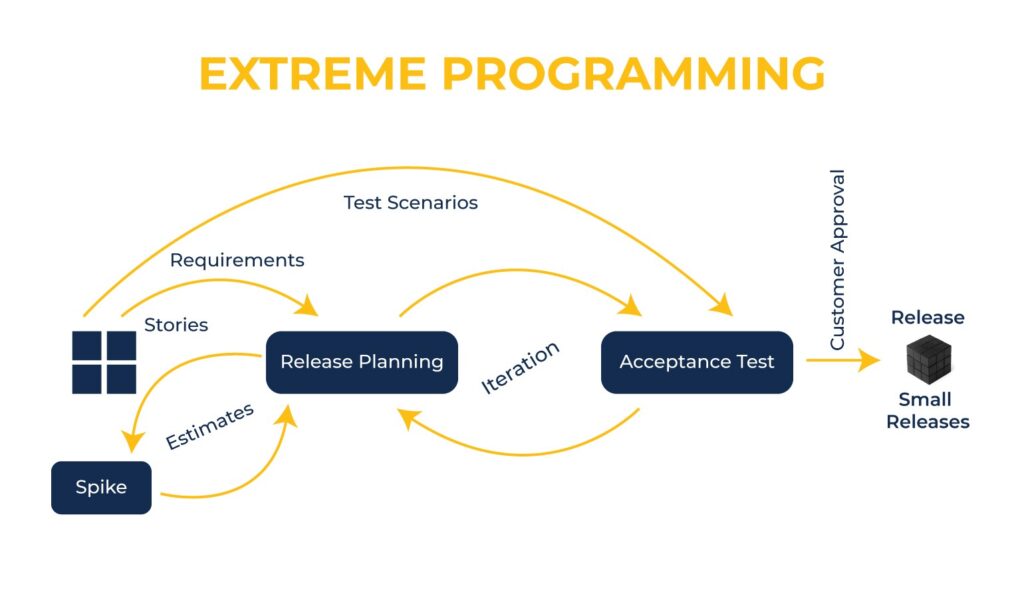
Using the XP software development approach involves close coordination with the customer. The customer defines and prioritizes their requested user stories.
Nevertheless, the development team decides to deliver the user stories that are a high priority as working software; they also ensure that these user stories are tested at every iteration.
XP is a lightweight framework that enables developers to deliver high-quality software using short development cycles and frequent releases. It employs pair programming, code review, unit testing, and periodic customer communication.
-
Crystal
Crystal is the last Agile methodology in our list of types of Agile methods. It is lightweight and flexible. Crystal focuses on people and interactions in an Agile project, including the priority of the system being developed.
It is premised on the realization that each project is unique and, therefore, requires a slightly customized set of practices, policies, and processes to complete it. Consequently, it offers the following set of Agile process models:
- Crystal Clear
- Crystal Orange
- Crystal Yellow
Every model has its own characteristics that are defined by various factors like team size, project priorities, and system criticality.
Like other Agile software development approaches, Crystal stresses the significance of frequent software delivery, a high level of customer engagement, elimination of red tape, and adaptability.
Communication, simplicity, and teamwork are the three principles this approach abides by. Let’s see the benefits of following Agile software development methodologies.
Benefits of Agile Development Approaches
Agile platform development is a philosophy centered around a mindset that values agility, flexibility, openness to change, and faster delivery of working software. Its goal is simple: to deliver precisely what the customer wants, when it wants.
So, here’s what you can expect to gain from adopting an Agile software development approach.
- Faster – speed is surely one of the most significant Agile benefits. If you shorten your software development cycle, it will offer cost savings that every business loves.
- Higher customer satisfaction – clients and customers form a pivotal part of any Agile methodology. Since Agile is iterative, customers routinely get the required software or something very close to the requirement. Due to its high adaptability, an Agile development system is very responsive to changes in customer demands, and its continuous improvement/delivery approach delivers software that satisfies customer demands and expectations.
- Removes rework – Agile is all about keeping the customer engaged in the development process. This means that there are few backtracks due to constant communication between the customer and the development team, and the need to redo something reduces.
- Values employees – another key benefit of Agile platform development is that it fosters a work environment where employees are highly valued. Team members are encouraged to give their ideas rather than follow a fixed plan – this culture is closely linked to one of the four values of Agile: responding to change is more important than following a plan. Moreover, under the Agile approach, employees are responsible for their project completion once goals have been set. That is because only the project team is aware of the nuances involved in the project, and thus they are best suited to deal with any hindrances that come their way.
Conclusion
As software development proliferates and reaches new heights, newer methodologies and approaches are also emerging. Agile is one of the most popular and widely used development approaches today. It has totally replaced the traditional waterfall development approach.
While Agile remains one of the best software development approaches today, it faces stiff competition from another development approach: DevOps. So far, DevOps has not entirely replaced Agile platform development, but many experts think it might do so in the coming years.
But then again, a newer approach could also replace DevOps someday. We never know; we only know that continuous improvement in methodologies and technologies is the only way forward.
If you need further guidance on Agile development, contact us at [email protected].
